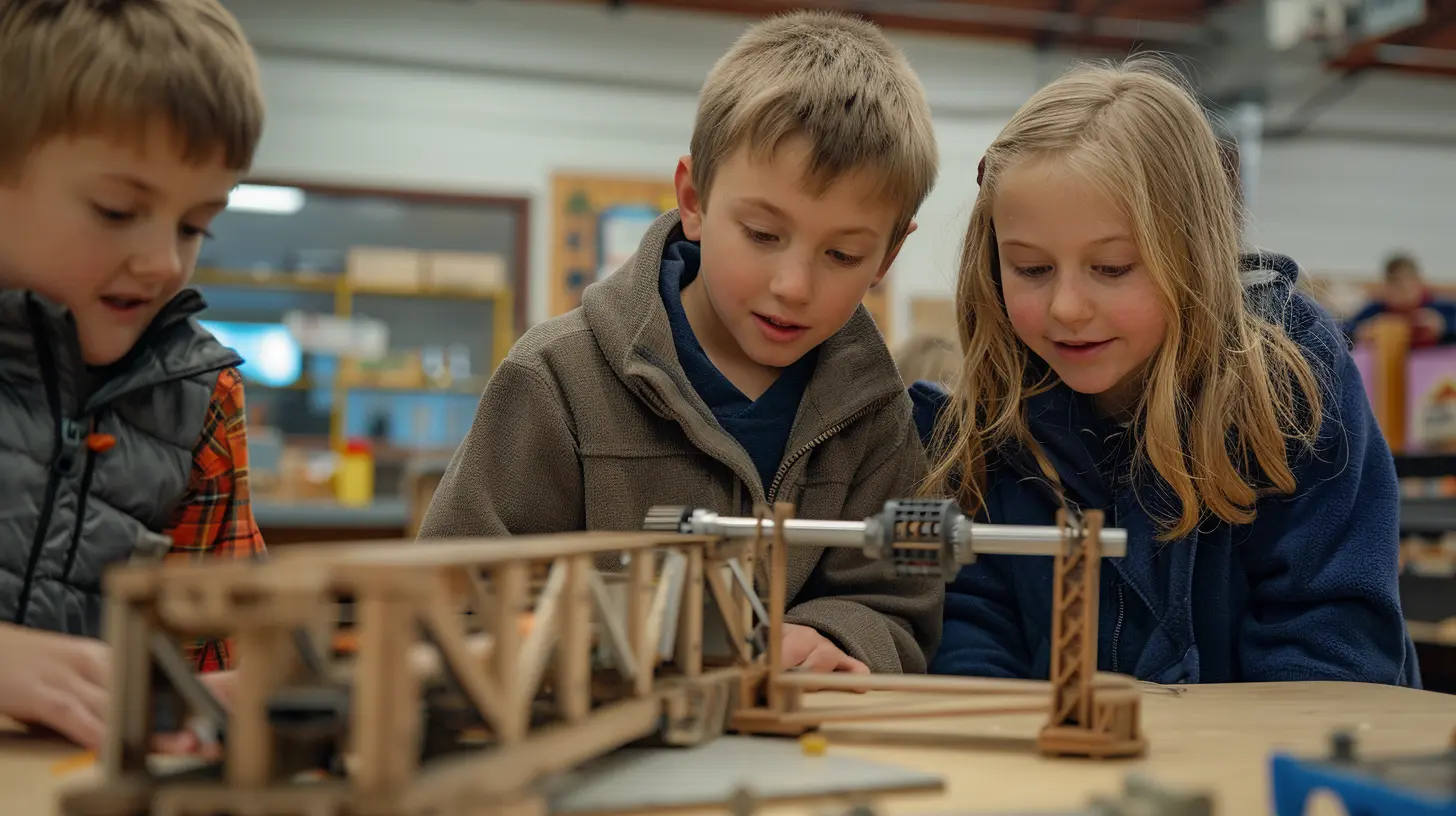STEM Challenges for Sparking Curiosity in the Classroom
8 November 2025
Ever tried getting a classroom full of students genuinely excited about learning?
Yeah, easier said than done. But throw in a little creativity, hands-on tinkering, and the occasional “aha!” moment, and suddenly you've got the attention of even the most distracted learners. That’s exactly where STEM challenges come into play.
In this article, we’re diving deep into how STEM (Science, Technology, Engineering, and Mathematics) challenges can take your everyday classroom and flip it into an engaging, curiosity-driven wonderland. Whether you're teaching elementary kids or high schoolers, STEM activities can light that spark of curiosity and get students thinking, questioning, and problem-solving like never before.
Let’s peel back the layers and see how this all works.
What Are STEM Challenges, Really?
At the heart of it, STEM challenges are problem-solving tasks that integrate concepts from science, technology, engineering, and math. But they’re not just geeks-in-lab-coats kind of problems. These challenges are often hands-on, real-world, and open-ended. Think of them as the educational version of Lego building meets Mythbusters.Instead of solving a worksheet full of equations, students might be building a bridge using spaghetti or designing a water filter with everyday materials.
Sounds more fun, right?
Why STEM Challenges Matter (Spoiler Alert: They’re Game Changers)
Let’s be honest—traditional teaching sometimes feels like spoon-feeding information. STEM challenges flip that script. Here's why they matter:1. They Make Learning Tangible
Kids don’t just hear or read about concepts—they touch them, build them, break them, and rebuild them. That’s powerful stuff.2. They Nurture Curiosity and Creativity
Got a student who always asks “Why?” or “What if?” STEM challenges were made for them. And for the quiet ones in class? It’s an open door to express themselves through creation.3. Collaboration Is the Name of the Game
Group-based problem solving encourages teamwork. Students learn to communicate, delegate, and listen—skills that go well beyond the classroom.4. Failure Becomes a Stepping Stone
STEM challenges normalize trial and error. Failure isn’t the end; it’s part of the process. And when students see that, they stop fearing it.
Key Ingredients for an Awesome STEM Challenge
Before we dive into some examples, let’s talk about what makes a good STEM challenge tick. Here are a few pointers:- Open-ended questions: No single right answer. Multiple solutions are welcome.
- Real-world relevance: Situations students can relate to or imagine happening in their lives.
- Constraints: Nothing gets the brain going like a few well-placed limits (ingredients, time, materials).
- Room for iteration: Allow students to tweak, test, and try again.
Now that we’ve got the framework, let’s dig into some cool ideas you can actually use.
STEM Challenge Ideas to Spark Curiosity (and Maybe a Little Chaos)
1. The Marshmallow Tower Challenge
Age Group: Elementary to Middle SchoolMaterials: Spaghetti sticks, tape, string, and one large marshmallow.
Objective: Build the tallest free-standing tower with the marshmallow on top.
Why it’s awesome: It looks easy, but it’s not. Students quickly bump into engineering concepts like stability, tension, and weight distribution. Creativity meets physics—plus, it’s wildly fun.
2. Protect the Egg! The Egg Drop Project
Age Group: Middle to High SchoolMaterials: Straws, rubber bands, paper, tape, cotton balls, etc.
Objective: Design a contraption that protects an egg from cracking when dropped from height.
This classic challenge teaches impact force, gravity, design optimization, and using minimal materials. Expect lots of broken eggs and lots of laughs.
3. Water Filtration System
Age Group: Middle School and AboveMaterials: Coffee filters, sand, gravel, activated charcoal, plastic cups.
Objective: Build a water filtration device that can clean dirty water.
Students learn about environmental science, water safety, and how real-world technology keeps communities safe. It’s a bit messy, but totally eye-opening.
4. Design a Paper Roller Coaster
Age Group: All agesMaterials: Paper, tape, scissors, marbles.
Objective: Create a functioning roller coaster that keeps a marble on track from start to finish.
It’s physics served with a twist of fun. Kids get to explore gravity, energy, friction, and momentum—all by playing architect and engineer.
5. Build a Bridge with Popsicle Sticks
Age Group: Middle to High SchoolMaterials: Popsicle sticks, glue, string.
Objective: Construct a bridge that can support the most weight.
This one brings out the competitive spirit. Students dive into engineering principles, learn about bridge types (truss, suspension, etc.), and test their design under pressure.
6. Sustainable City Design
Age Group: High SchoolMaterials: Cardboard, colored paper, recycled materials, markers.
Objective: Design a model of a sustainable city with clean energy, waste management, and efficient transportation.
This challenge integrates environmental science, urban planning, and creativity. It's great for deep discussion and reflective thinking.
Making STEM Challenges Accessible for Everyone
You don’t need a high-tech lab to make these challenges work. Seriously, some of the best ideas need just basic classroom materials—and a dash of imagination.Here are some quick tips for making your STEM activities inclusive:
- Let students choose roles: Some love building, others like leading, and some want to draw or present ideas.
- Offer voice and choice: Let students pick which challenge they want to tackle.
- Encourage journal reflection: Let them jot down ideas or draw prototypes. It helps all learners process information differently.
- Provide flexible scaffolds: Give a starting point or hint, but not the solution.
Bottom line? Keep it flexible and fun.
How to Integrate STEM Challenges into Your Weekly Schedule
Okay, so you’re inspired—but your schedule is packed. We get it. Here's how to slide STEM seamlessly into your routine:Start Small
Try a quick 20-minute “Friday Fantastic Fix” where students solve a mini problem just before the weekend.Connect to Curriculum
Tying challenges into your current topics makes concepts stick. Learning about forces in science? Do the egg drop. Teaching geometry? Build structures with straws.Make It Cross-Disciplinary
STEM doesn’t have to live in a silo. Math blends with art when students design blueprints. Writing meets tech when they blog about their solutions.Use Exit Tickets
After the challenge, ask reflective questions like:- “What would you change next time?”
- “What was the hardest part?”
- “How did your team solve arguments?”
These quick assessments help evaluate learning while encouraging growth.
Assessing STEM Without Killing the Vibe
Yeah, grades matter—but STEM challenges are more about process than product. So how do we assess that?Here’s a simple rubric idea:
- Creativity (25%) – Was the solution unique or innovative?
- Collaboration (25%) – Did everyone have a role and contribute?
- Design and Construction (25%) – Was the project well thought out and functional?
- Reflection (25%) – Did they learn from mistakes and explain their thinking?
You get insight, and students get feedback that actually helps them grow.
Real Talk: Challenges You Might Face (And How to Crush Them)
No sugar coating here—STEM challenges come with their own hurdles. But don’t panic. Here’s what to look out for:Limited Resources?
Solution: Go DIY. Recycle, reuse, or write a wish list for parents. You'd be surprised what they’re willing to donate.Time Constraints?
Solution: Break challenges into bite-sized pieces across the week. Day 1: Plan. Day 2: Build. Day 3: Test and Reflect.Mixed Skill Levels?
Solution: Group students intentionally. Mix strengths so each group becomes a mini think tank.Final Thoughts: Lighting the Fuse of Curiosity
STEM challenges aren’t just another activity—they’re a mindset. They teach perseverance, cooperation, innovation, and the sheer joy of figuring things out on your own (or together).You don’t need to be a science genius to bring this into your classroom. You just need a little courage, a few supplies, and a belief that your students can do incredible things when given the chance.
So go ahead—shake things up. Start small, dream big, and let curiosity lead the way.
Who knows? The next great inventor might be sitting right there in your third period class, just waiting for the right challenge to come along.
all images in this post were generated using AI tools
Category:
Classroom ActivitiesAuthor:

Madeleine Newton
Discussion
rate this article
1 comments
Bridget Bailey
Thank you for this insightful article on STEM challenges! Your suggestions for igniting curiosity in the classroom are both practical and inspiring. I particularly appreciate the emphasis on hands-on learning experiences. This approach not only enhances student engagement but also fosters a lasting love for science and technology. Great work!
November 8, 2025 at 5:41 AM

Madeleine Newton
Thank you for your kind words! I'm glad you found the article helpful and inspiring. I truly believe hands-on learning is key to igniting curiosity in STEM.


